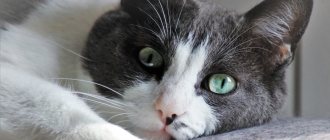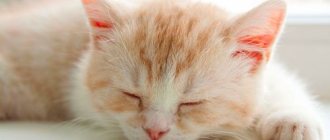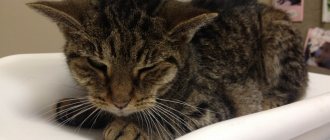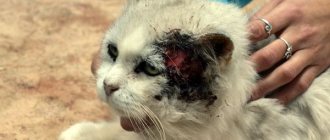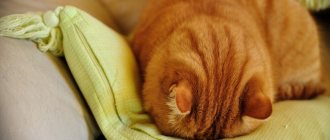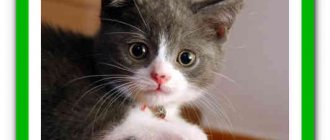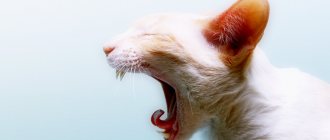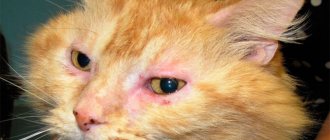False pregnancy in cats: what is it?
This is the name of a pathological (in the case of cats, truly pathological, more on that below) condition in which the animal not only looks like it is pregnant, but also “considers” itself to be so. There is no real pregnancy, as is easy to understand.
And I would like to immediately clarify one important nuance. Experienced “cat lovers” often claim that false pregnancies do not occur in cats at all. In part, they actually have reasons for such categorical statements: when compared with dogs, the frequency of imaginary pregnancies in cats is negligible. But if you look at the general statistics specifically for cats, everything becomes not so rosy. Although rare, there are also cases of “idle” in cats.
In dogs, this condition is natural, developed during centuries of evolution. Due to this, a pack of wolves can easily feed a dozen or two wolf cubs whose mothers died hunting: “false” females will feed them. Even if their pregnancy is not real, the milk they produce is the most natural!
But in cats, imaginary pregnancies are a very bad sign. For these animals they are unnatural and often indicate dangerous pathologies of the reproductive system.
In addition, in nature, cats are not known to be excessively “altruistic”: females not only do not accept or feed other people’s kittens, but even kill them (though not always, but very often).
Measures to treat false pregnancy
The best treatment is prevention; even a one-time phenomenon of pseudo-pregnancy disrupts physiological processes in the body, which are not noticeable at first, but in combination with other factors - severe.
To neutralize the symptoms of the “spoon” you need:
Swelling of the mammary glands
- follow a diet (minimum dairy products, more carbohydrates, cereals);
- give unlimited access to clean water;
- carry out sedative therapy (sedatives: “Anti-stress”, “Xylazine”, “Stop-stress”, have a gentle effect on the central nervous system, change behavior);
- hormonal therapy is prescribed by a veterinarian for prolonged and frequent pseudopregnancy;
- Vitamin and mineral therapy are needed to maintain the normal functioning of the cat’s body and strengthen the immune system.
If mastitis is present, treatment is mandatory. If the owner notices that the cat has milk in its nipples, you should immediately contact a veterinary clinic. In the early stages, milk stagnation can be prevented and infection can be prevented. Treating mastitis is much longer and more difficult, and if unfavorable conditions develop, a mastectomy will be required, that is, complete removal of the mammary gland strip on both sides.
Causes of false pregnancy in cats
Let's consider the main reasons for the development of pathology. What happens most often is this:
- It happens that a false pregnancy is the result of a “spree” with a recently castrated male (or a cat whose sterility is a consequence of other reasons). Those. in such a situation, there was sexual intercourse, mechanical stimulation of the external genitalia occurred, the ovaries “spit out” the egg... but in fact there were no sperm capable of fertilizing it. In this case, the female’s body can become “confused,” up to the development of a full-fledged corpus luteum, the beginning of prolactin synthesis, etc.
- However, castrati rarely retain the ability to copulate, and sterile cats “in the wild” are not very common. It is much more likely that the cat herself has problems with the reproductive system. Those. and there was sexual intercourse, and the release of the egg occurred, but... For some reason, further development of the gamete is inhibited or even stops, but the body already “gets a taste” and “feels” itself pregnant.
- In very rare cases, severe and prolonged stress may be to blame. For example, moving, long and unsuccessful renovations in an apartment, etc.
Causes of pseudopregnancy
False pregnancy appears 4-8 weeks after estrus. The factors influencing the appearance of the syndrome have not been thoroughly studied.
It is assumed that the cat begins to prepare for bearing offspring for the following reasons:
- Mating with a neutered cat. During the castration procedure, or rather its unfair implementation, only 1 testicle can be removed from a cat, due to the fact that the second one is not lowered into the scrotum. Also, in cats, after sterilization, the hormonal levels do not change immediately. It takes from several weeks to six months (individually). Such cats exhibit sexual activity.
- Mating with an infertile cat.
- Conception may not occur if the female suffers from endocrine diseases or congenital anomalies of the reproductive organs.
- In the absence of mating, the condition occurs if there is a second pregnant female in the house. In this case, the animal’s psyche is influenced by “envy”.
- When a cat with kittens and a nulliparous female are kept in the same house, the kittens can absorb her mammary glands.
- Experienced stress. Increased anxiety leads to the production of the same hormones as during pregnancy. A whole complex of symptoms develops, causing the cat to “believe” that she is expecting offspring.
- Predisposition. The following breeds are predisposed to false tightness: sphinxes, rexes, orientals.
Why is pathology dangerous?
So why is imaginary pregnancy dangerous in cats? To many:
- Since these pets often develop it for a reason, but against the background of quite serious hormonal disorders or pathologies of the reproductive system, with special “luck” it can lead to oncology.
- It has been noticed that cats that have had an “empty” pregnancy two or more times in a row are subsequently practically useless from the point of view of reproduction. They either become worse pregnant, or their offspring are weak and nonviable.
- The likelihood of pyometra, chronic endometritis and ovarianitis (inflammation of the uterus and ovaries, respectively) increases.
Mastitis during false pregnancy
But still, more often than not, cat owners face another problem. Mastitis during false pregnancy occurs very often. The problem is that cats themselves are extremely difficult to tolerate inflammation of the mammary glands; the risk of death is quite high.
The mechanism of mastitis development in this case is very simple:
- Since during a false pregnancy milk secretion occurs regularly, but there is no one to suck it out, the liquid constantly accumulates in the alveoli and milk ducts.
- Gradually, the pressure becomes such that the milk flows by gravity (sometimes with force, as if from a spray bottle) out of the nipples.
- If these streaks are not removed in time and the skin is not wiped, the milk turns sour, creating excellent conditions for the development of pathogenic and conditionally pathogenic microflora. Gradually, the microbes will penetrate into the mammary gland itself and cause inflammation there.
With this pathology, the nipples and adjacent tissues become very hard, and local and general body temperature rises. The slightest touch to the nipples results in inappropriate behavior of the animal, to which palpation causes unbearable pain.
Important! Treatment in a clinical setting is urgently required, as otherwise the cat could easily die.
In particular, with the slightest delay, inflammation easily turns into a purulent form, when thick, yellow-green pus begins to secrete from the nipples. The probability of successful treatment is 50/50 (in other words, depending on your luck). In addition, in advanced cases, sterilization is almost always required.
What are the complications?
Mastitis can be the result of a problem left to chance.
If a false pregnancy is not eliminated, consequences arise, such as:
- Mastitis. It is characterized by inflammation of the mammary glands, which can lead to an abscess and death.
- Cancer formation. The condition is provoked by inflammatory processes in the internal genital organs, which disrupts blood circulation and disrupts the cell cycle.
- Pyometra. This is a purulent inflammation of the endometrium, which provokes hormonal imbalance and poses a threat to life.
How to distinguish a false pregnancy from a real one
So how to distinguish a false pregnancy from a real one based on a set of mental signs? In general, this is not so easy to do; you need to pay attention to many small nuances:
- A “false-positive” cat’s mood changes very often and completely unpredictably. At one moment she can be active and playful, and after a few minutes she begins to hiss and avoid people.
- Some cats become overly affectionate, while others hiss and run away from their owner, even if they previously could not live without his constant attention.
- If during a normal pregnancy the animal begins to look for a place to give birth a couple of days (a week) before the birth, then during a false pregnancy it does this constantly, which drives the owners into hysterics. A cat can rummage through closets all day long and for at least three weeks, “inspecting” the most remote corners of the house.
- Again, “preliminary” postpartum behavior is extremely uncharacteristic of a normal pregnancy. But with pathology, a cat that does not have and never had kittens begins to carry socks, slippers, small boxes and other “garbage” in its teeth, which it perceives as kittens.
It happens that during a false pregnancy, a cat becomes incredibly noisy: she constantly yells, demanding attention, meows and “squeaks.” Sometimes animals seem to “go crazy”, they become violent and completely uncontrollable. This happens due to an abnormal surge of hormones, as well as when hormones appear in the bloodstream, the combination of which is normal or does not exist at all, or their concentration is much lower.
Discharge and other physiological signs of pathology
These signs are no longer subjective and are clearly visible to the naked eye:
- There is mucous discharge from the vulva. And if during a normal pregnancy they are rare and not too regular, then during a false pregnancy, mucous discharge from the external genitalia is constantly observed.
- The abdomen enlarges and sags. Again, with normal gestation of kittens, this sign does not develop immediately, while with a false pregnancy, the cat may already look as if it is about to give birth in the second week.
- The cat's appetite first increases and then worsens. In a normal pregnancy, the opposite is true: in the first half of gestation, the cat eats worse, but then the appetite quickly increases.
- A riot of hormones often leads to frequent gastrointestinal disorders.
- In addition, this pathology is quite characterized by a chronic increase in general body temperature.
What do the mammary glands look like during a false pregnancy?
Note that the mammary glands of a “false-positive” pet look exactly the same as if she were actually pregnant:
- The nipples become noticeably enlarged and swollen.
- As we mentioned above, milk production begins.
We also note that not all cases develop all of the above symptoms. Their appearance/non-appearance depends both on the specific case of pathology and on the psychophysical state of the cat. In addition, some pets have an extremely difficult time experiencing the state of an imaginary pregnancy, sometimes it even comes to real mental “oddities”.
Other cats may perceive their condition as a minor inconvenience. Accordingly, in the latter case, the likelihood of severe consequences is much lower, and there are much fewer reasons to visit the veterinarian.
General concept of false pregnancy
False pregnancy is a special condition when a cat experiences all the symptoms of pregnancy without actually having one. Why is this happening? During the period of ovulation, the formation of the corpus luteum occurs in the animal’s reproductive system. In normal health, when there are no hormonal or endocrine disorders, the corpus luteum dies.
But if there are any abnormalities in the animal’s body, the process of death of the corpus luteum does not occur, and it begins to produce hormones characteristic of pregnancy. For example, the pregnancy hormone prolactin begins to be actively produced, which is responsible for changes in the condition and functioning of the mammary glands, stimulating the production of breast milk.
As a result of the production of hormones appropriate to pregnancy, the animal appears all the signs characteristic of successful fertilization. Not only the physiology of the animal changes, but also its psycho-emotional state. After all, the body will rebuild itself while waiting for a non-existent litter.
The period of false pregnancy lasts on average from 1 to 1.5 months.
Moreover, this period will be extremely painful for the cat.
What to do and how to calm a cat at home?
Firstly, you need to figure out when you need to take some steps, and when the animal’s body can overcome the attack on its own. So, you need to do something yourself or immediately contact a veterinarian in the following cases:
- False pregnancy lasts more than three weeks and there are no visible signs of normalization of the animal’s condition.
- The cat becomes extremely nervous or so apathetic that it resembles an amoeba.
- It is necessary to immediately take your pet to the clinic if there is a suspicion of mastitis (and even more so if there are pronounced clinical signs of inflammation).
If you don’t have all this, here’s what to do and how to calm your cat at home:
- It is necessary to reduce the animal's consumption of any liquid by approximately 1/3, including moisture from canned or natural food. This is the most important condition!
- For the same reasons, we recommend increasing the total proportion of dry food in your pet’s diet.
- It is necessary to protect the cat from contact with its relatives.
- It is also necessary to play with your pet and communicate with it more often. The more often the owner does this, the less time the animal will have to select a place “for birth”, the faster it will calm down and return to normal.
- You should not be nervous and scold the cat, as this will only make everything worse.
Features of false pregnancy therapy
Therapy of the pathological process is complex and includes:
- Compliance with dietary nutrition.
- Providing your pet with enough fluid and drinking it regularly.
- Taking medications with a sedative spectrum of action.
- Prescription of drugs that stop the process of breast milk production and completely stop lactation.
- Massages.
- The use of traditional medicine methods - internal administration of decoctions based on medicinal herbs.
- Prescription of antibacterial spectrum drugs, non-steroidal anti-inflammatory drugs.
During the treatment period, the owner requires careful care of the pet and maximum attention.
In order to stop the process of milk production, it is recommended to start not with medications, but with nutritional adjustments.
It is necessary to limit the amount of dairy products, or even better, to completely abandon them. In addition, there should not be a large amount of carbohydrates in the animal’s diet.
If the process of milk production is delayed, this can further have an extremely negative impact on the cat’s health, for example, provoke the development of mastitis. It is recommended for your pet to have regular massage of the mammary glands to prevent stagnation of milk.
If the process of milk stagnation was missed and the cat began to develop mastitis, treatment includes taking antibacterial drugs. Veterinarians recommend using antibiotics such as Cyclozocin or Naloxone. Giving them to your cat on your own without the knowledge of a veterinarian is prohibited.
The dosage of these antibiotic medications is determined by the veterinarian solely on an individual basis, and exceeding the amount of the drug or its improper use can cause the development of serious side symptoms. Before using antibiotics, it is recommended to give the animal an antiemetic drug, for example, Metocloramide.
Veterinary experts also recommend taking sedatives that will help restore the cat’s psycho-emotional background and relieve behavioral symptoms - Nutri-West, Fitex, Kot Bayun.
Drugs for treatment in clinical settings
Please note that medications to eliminate the manifestations of false pregnancy in cats can and should only be prescribed by a veterinarian! Many of these medications can kill a cat if used incorrectly.
At the clinic, doctors use sedatives (at least simple Diphenhydramine) to calm the animal. To stop milk production, hormonal prolactin antagonists are used. To treat mastitis, it is often necessary to resort to anti-inflammatory corticosteroids in combination with broad-spectrum antibiotics and other antimicrobial drugs.
Remember! Hormonal therapy is resorted to only in the most difficult cases, since in such situations the animal’s condition can easily be aggravated.
And even more so, we do not advise owners to buy and prescribe these medications to their cats on their own: the risk of permanently undermining the cat’s health is maximum, but there is almost no chance of curing the pet on their own.
What to do
The animal needs to be examined. After diagnosing that a cat has a false pregnancy, measures need to be taken. Sometimes care and a change in diet are enough for her to return to normal life in a month.
It is necessary to reduce fluid intake and avoid fermented milk products. They promote milk production. Remove all objects that evoke maternal feelings in the cat.
Spend more time with the cat, distract it with games, pet it, show care. Perhaps the lack of attention from the owners was caused by nervous stress, and the cat began to develop a false pregnancy. It will gradually calm down, hormonal levels will normalize, and the body will understand its mistake.
In a cat, a false pregnancy can cause a number of complex pathologies - mastitis, inflammation of the uterus, ovaries, suppuration of the mammary glands, thyroid tumor; it is worth carefully examining the animal. Serious therapy may be required.
Prevention of false pregnancy in cats
In general, imaginary pregnancy in cats is a relatively infrequent phenomenon, and therefore there are simply no studies studying the prevention of pathology. In fact, the only prevention that works 100% is sterilizing the cat. Moreover, to prevent estrus and “pregnancy,” it is imperative to remove not only the uterus, but also the ovaries. In addition, it is necessary to treat all hormonal pathologies in a timely manner by contacting a veterinarian. All oddities in the cat’s behavior should also not go unnoticed by the owner: if something worries him, it is better to immediately take his pet for a preventive examination to a specialist.
Prevention
Owners of cats prone to this disease need to more closely monitor the health of their pet. Mating should only be carried out with cats that are known to be healthy. A few weeks after this, be sure to do an ultrasound examination in order to make sure that pregnancy has occurred.
One of the most important preventive measures is proper diet. Overfeeding an animal can affect not only metabolic processes, but also hormonal processes, causing them to malfunction. In addition, the cat must be protected from possible stress and shock, which can also provoke a false pregnancy.
Why does false pregnancy occur?
Pseudopregnancy is not only a physiological, but also a psychological state of a cat. All her sensations arise for different reasons. As a result, for 3-4 weeks or more, the cat will feel almost all signs of the presence of a fertilized egg in its body, although there is no embryo in the uterus. False pregnancy can appear once or occur constantly after another estrus.
A cat’s corpus luteum forms after mating, even if the mating was “empty” due to cat health problems or contact with a castrated cat. After a few weeks, the corpus luteum will resolve, but until this happens, the animal may experience a state of pseudo-pregnancy. During this time the heats disappear.
Causes:
- “empty mating” - the cat is castrated or has a reproductive disorder and is not able to fertilize a female;
- diseases of the cat's reproductive system;
- stress becomes a strong irritant for a cat who is looking for solace in a state of pregnancy.
- imitation of constantly giving birth to cats - simulation due to constant observation of another animal that lives with you. The phenomenon is rare, but possible.
Eliminating the consequences of a non-existent pregnancy
As mentioned above, false pregnancy in cats also has physiological symptoms that are a consequence of their mental disorders. The consequences of playing “mother-daughter” often have to be treated with medications. In particular, lactation processes initiated by the brain must be stopped in order to avoid the appearance of various diseases of the mammary glands. This must be achieved, first of all, by excluding dairy products from the furry pet’s diet.
In more advanced cases, special massage may be required to reduce milk production. When purulent mastitis develops, treatment will be more complex: antibiotics cannot be avoided. In addition, in most cases, the veterinarian prescribes hormonal medications.
It turns out that this strange behavior of the cat is caused by natural necessity. At first glance, the disease may seem absurd, but everything has its own explanation. The maternal instinct in cats is developed quite strongly; they are able to feed other people's offspring. An imaginary pregnancy can help a female who has never given birth raise and feed completely healthy cubs.
It is also considered an interesting fact that domestic cats have often been observed attempting to create collective nests, similar to lion prides, where the babies are raised all together, in turn, starting with the older ones. This instinct is inherent in wild animals to make it easier for them to protect their territory from strangers. In addition, the younger generation providing assistance in caring for kittens has an excellent opportunity to gain invaluable practice.
How does this disease manifest itself in cats?
Signs of a false pregnancy are changes in the physiological and psychological state of the cat after the period of estrus. The family favorite considers herself fertilized and is expecting imaginary offspring. In this regard, features characteristic of false pregnancy in animals appear:
- the nipples of the mammary glands swell and increase in size;
- Colostrum appears, and then milk;
- the belly grows;
- increased appetite and constant feeling of thirst;
- vaginal discharge.
Long before the onset of false birth, females begin to thoroughly prepare. Firstly, they look for a secluded place to protect future babies. Often the “shelter” in an apartment is the pantry or the far corner behind the sofa. Having “gave birth” to non-existent kittens, the cat begins to drag around the house everything that is in some way similar to the cubs: socks, balls, slippers, toys, etc. Mother cats absolutely seriously see their own children in household items, and it is not surprising that they will protect the “babies” from their home owners.
Treatment
The cat's disease is treated comprehensively. Experts prescribe therapy:
- Sedatives – to relieve stress, restore the nervous system;
- Ointments to relieve inflammation;
- Compresses with a cooling effect for the mammary glands to relieve swelling and inflammation;
- In the presence of hidden infections, severe forms of the disease - antibiotics;
- Hormonal drugs.
Surgical intervention with removal of the ovaries is performed in situations that are dangerous to health and life:
- False pregnancy in cats occurs regularly;
- There is a predisposition to the appearance of a neoplasm;
- Endometritis and some other diseases of the reproductive system are present.
In a cat, false pregnancy is a pathology and must be dealt with. To prevent mastitis, massage, cooling compresses, and tightening bandages are recommended.
When the disease develops, it is treated with anti-inflammatory drugs, antibiotics, and hormonal drugs. With the right approach, a false pregnancy in a cat goes away within a few weeks, and readiness for a full pregnancy appears already during the next heat.
In cats, false pregnancy is most often treated with the drug Naloxone. Tablets are given twice a day, the duration of therapy is prescribed by a specialist, depending on the condition of the animal. The dose is calculated based on the weight of the animal - 0.01 mg per kg of body weight.
Since the drug causes disruption of the gastrointestinal tract - nausea, vomiting, an antiemetic drug - Metoclopramide, Reglan - should be given 40 minutes before.
False pregnancy requires individual treatment; methods depend on the frequency of its manifestation, the characteristics of the body, and the presence of concomitant diseases. It is worth noting that similar pregnancy of a cat in the wild also happens, but much less frequently, it goes away on its own, and is finally treated with the onset of natural pregnancy.
Not so long ago, false pregnancy in cats did not cause worry or anxiety for the animal either among owners or veterinarians. This phenomenon was not considered any pathology. Yes, all experts in the field of animal medicine recognized that the cause of this condition in furry pets is a hormonal imbalance, but all recommendations for treatment were reduced only to a diet and drinking less.
Based on the name, it is easy to guess the signs of this condition of the animal. The cat has all the symptoms of an “interesting situation”, but the owners know for sure that no mating took place, and therefore nothing like this can happen. A severe disruption in the animal’s hormonal system can lead to such a serious illness, and the consequences of the disease have consequences not only for the cat itself, but also for the owners and surrounding animals.
Pedigree predisposition
It was long believed that this condition could occur in any cat. However, today experts agree that there are 3 breeds that are most vulnerable. These are the Rex, the Sphynx and 15% of individuals of these breeds have had cases of false pregnancy. In this case, the observed symptoms in a mother cat are necessarily inherited by her female kittens.
Usually, if fertilized during the next heat, the cat is able to carry and give birth to healthy offspring. If it is not a breeding animal, veterinarians recommend sterilizing such an animal. A false pregnancy in a cat brings too much harm to physical and mental health. After sterilization, it happens that swelling of the nipples is observed, but then this quickly passes and does not recur.
It is believed that false pregnancy is more of a dog problem. But, recently, this phenomenon is becoming more common in cats. There can be many reasons for this. One of them is the excessive domestication of cats. Many owners never let her go outside, limiting all communication outside the apartment. This negatively affects the mental and emotional state of the animal.
